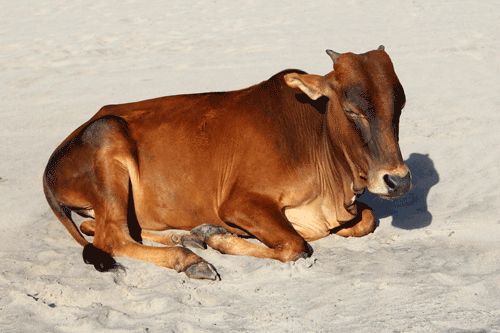What is Ruminal Tympany?
Ruminal tympany or bloat is a clinical condition in which the excessive accumulation of gas occurs in the rumen which results in distension of left abdominal wall. There are two types of tympany– Primary Tympany which is dietary in origin and Secondary Tympany which occurs due to inability of eructation of gases from rumen.
There is increase in girth of left flank region. Progressive distension of rumen also exerts pressure on thoracic organs, pressure exerted on diaphragm may reduce lung capacity which might lead to death due to hypoxia.

Ruminal tympany is a very commonly found condition in ruminants such as cattle, buffaloes. Sometimes in order to increase milk/meat production, the farmer gives unnecessary extra ration in form of grains or green fodder or both to animals which results in condition of bloat. Moreover farmers in rural areas do not have ample knowledge and may give bloating green forages such as green cereal crops, rape, kale, turnips, and legume vegetable crops. to cattle especially in seasons of spring and autumn when the fodder is lush green and young.
What causes Ruminal Tympany?
Primary tympany or frothy bloat is caused due to formation of foam which entraps the fermentation gases in rumen, lower ruminal pH that aids in foam stabilization. Leguminous green fodder contains soluble leaf proteins which have foaming qualities resulting in bloat. Other than legumes, crops like rape, cabbages, cereal crops if ingested by the animals may produce bloat occasionally. Bloat producing diets also favour the growth of ruminal microbes which are capable of producing a ‘slime’ which contributes to stable foam formation. Feed with high moisture content, immature forage and the environmental factors like rainfall, temperature also aid in formation of bloat.
Secondary tympany or free gas bloat is caused either by physical obstruction in the path of gas eructation by a foreign body or due to disease condition like tetanus in which muscle spasm occurs. In condition like grain overload, fermentative gases are formed but the contractibility of rumen is impaired resulting in free gas bloat.
Symptoms to look out for Tympany
The characteristic symptom of bloat is distension of abdomen apart from this, other symptom observed are animal standing with legs abducted, animal feeling restless, lie down and get up frequently, labored breathing, frequent urination and defecation, refusal to eat. In worse conditions hypersalivation, difficulty in breathing, open mouth breathing , frequent urination and defecation, passing soft faeces, abrupt cessation of milk production, elevated respiration rate and heart rate may be observed. On auscultating left flank region, tympanic sounds can be heard produced by free gases. With these symptoms and feeding history of animal, bloat can be diagnosed easily.
Treatment
Treatment for the bloat depends solely on its cause. It is advisable to call a veterinarian in time before the case becomes life threatening. In emergency cases, rumenotomy (surgical procedure) is done to save the life of the animal. Release of ruminal content and gas by using instruments like trocar cannula can be done. Once the pressure reduces, antifoaming agents can be given intraruminally via cannula. Stomach tube can also be used unless the situation is life threatening.
In case of frothy bloat, vegetable oil or mineral oil can be given to dissolve the foam. Oils like groundnut oil, turpentine oil which are available locally can be used. Veterinarian may also give antibiotics intraruminally to limit the bacterial multiplication responsible for bloat. Ginger, asafoetida and garlic 10g each and 100g of onion can be ground well to form a paste and be applied on the tongue of the animal. Baking soda (sodium bicarbonate) can also be used by mixing in water and giving to the animal. After treatment, the cow is mostly likely to burp in order to release the gas. Massage the rumen area with firm long strokes from the abdomen towards the spine. Oil and baking soda remedies for bloating cattle work by dissolving the foam that fills up the rumen.
Preventive Measures
It is an age old adage that prevention is better than cure and in order to prevent the condition of bloat, following things should be kept in mind:
- Never give young immature forages in the feed
- Do not feed excess ration to the animal
- Include antifoaming supplements like groundnut oil in the daily diet of cattle
- Cows should be fed hay or straw before allowing them in pastures
- Keep the pastures free of bloating forages
- Call a veterinarian in case any tympany symptoms are observed
Conclusion
Feeding green succulent fodder to cattle in excess especially young, immature forage can lead to the condition of ruminal tympany. This condition of ruminal tympany can be fatal if not treated timely. Most of the time, the condition arises out of dietary mismanagement. Thus it seems likes the green succulent fodder is, after all, not so greener in case of animals.
| The content of the articles are accurate and true to the best of the author’s knowledge. It is not meant to substitute for diagnosis, prognosis, treatment, prescription, or formal and individualized advice from a veterinary medical professional. Animals exhibiting signs and symptoms of distress should be seen by a veterinarian immediately. |






Be the first to comment